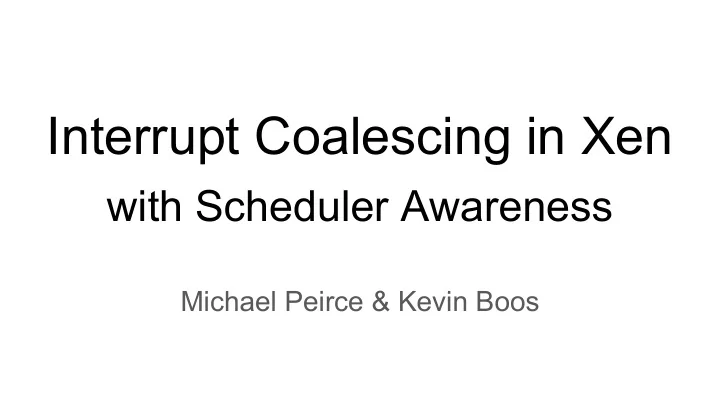

Interrupt Coalescing in Xen with Scheduler Awareness Michael Peirce & Kevin Boos
Outline ● Background ● Hypothesis ● vIC-style Interrupt Coalescing ● Adding Scheduler Awareness ● Evaluation 2
Background Xen split block drivers 3
Background: Xen block drivers dom0 domU guest blkback blkfront driver Xen hypervisor 4
Background: ring buffers dom0 domU guest blkback response blkfront consumer driver RSP1 RSP2 RSP3 request response producer producer REQ6 REQ5 REQ4 ring buffer request (in shared page) 5 consumer
Background: interrupt event channels dom0 domU guest interrupt: requests pending blkback blkfront driver interrupt: responses pending Xen hypervisor 6
Focus on blkback dom0 domU guest interrupt: requests pending blkback blkfront driver interrupt: responses pending Xen hypervisor 7
Hypothesis 8
Hypothesis 1) Coalescing interrupts in Xen will increase throughput of block devices at minor latency cost (vIC) ○ fewer interrupts reduces CPU overhead 2) Scheduler awareness will improve upon existing coalescing policies by reducing latency ○ less coalescing towards end of timeslice ○ minimal reduction in throughput 9
Conventional Interrupt Coalescing VMware vIC 10
VMware-style Coalescing (vIC) ● Interrupt coalescing is absent in Xen ● Added conventional coalescing based on VMware’s vIC ● Interrupt delivery ratio based on configurable parameters: ○ IOPS threshold ○ CIF threshold ○ (Epoch period) ● Implemented in dom0’s kernel, in xen_blkback module ○ On each block_io completion event, decide whether to deliver interrupt 11
vIC Implementation Diagram dom0 domU guest measure IOPS & CIF interrupt: requests pending blkback blkfront driver coalesce interrupt: responses pending Xen hypervisor 12
Default Interrupt Delivery (no coalescing) Guest 1 Timeslice Guest 2 Timeslice Core 1 10 interrupts Dom0 Core 2 Device interrupts from Hypervisor time 13 20ms 30ms
Increasing Disk Throughput in vIC Guest 1 Timeslice Guest 2 Timeslice Core 1 5 interrupts Dom0 Core 2 Device interrupts from Hypervisor time 14 20ms 30ms
Scheduler Awareness 15
Latency Problems in vIC Guest 1 Timeslice Guest 2 Timeslice Core 1 Dom0 Core 2 Device interrupts from Hypervisor time 16 20ms 30ms
Reducing Latency Guest 1 Timeslice Guest 2 Timeslice Core 1 Dom0 Core 2 Device interrupts from Hypervisor time 17 20ms 30ms
Hybrid approach: vIC + scheduler awareness ● Should we use a separate interrupt delivery policy based on scheduler info alone? ○ No, too coarse-grained and unintelligent ● Use scheduler info to configure vIC’s parameters & ratio ● Hard guarantee that interrupts will be delivered right at the very end of a timeslice ○ “end of timeslice” cutoff is configurable 18
Exposing scheduler info from hypervisor ● Easy way: add hypercall to retrieve scheduler info ○ Pros: easy to implement, info generated on demand ○ Cons: high overhead, long latencies → stale info ● Hard way: shared memory region with dom0 ○ Pros: info is fresh, available immediately ○ Cons: info is updated constantly, very difficult to implement 19
Implementing shared scheduler info ● Xen allocates a shared page for each domain when it boots ○ boot info, arch-specific details, interrupt masks/bit vectors ● Added scheduler info to shared page ○ One per domain (except idle & dom0) ○ Only visible in dom0 ○ Updated in hypervisor’s schedule() ● Much difficulty with time synchronization 20
Scheduler Awareness Implementation Diagram dom0 domU guest measure IOPS & CIF interrupt: requests pending blkback blkfront driver coalesce interrupt: responses pending Xen hypervisor scheduler 21
Scheduler Awareness Policy We choose to deliver an interrupt when: 1 remaining time in timeslice < (Ratio * IOPS) Dom0 22
Evaluation 23
Evaluation Setup ● Default credit scheduler enabled ● dom0 pinned to two CPU cores, reserved for dom0 only ● All guests pinned to the same single core ○ Eliminates effects of migration ○ Imitates guest CPU contention on high-density servers ● Tools to generate disk workload: ○ Copy files with dd, small block size to create more I/O requests ○ Custom interrupt injection tool 24
Evaluation Questions vIC ● Can we achieve higher throughput with minimal latency? ● Can we achieve the same increased scheduler throughput as vIC with less latency? awareness 25
Throughput Measurement ● Copy files using dd tool with small block size of 8 & 512 bytes ○ Measure execution time of 1GB file transfer 26
Throughput Results One guest performing I/O, others hogging CPU 27
Throughput Results All guests performing I/O, all guests hogging CPU 28
Latency Measurement ● Instrumented frontend block driver in the guest kernel ○ Assign (guest-specific) unique ID to each request ○ Start timer when request is submitted ○ End timer when response is received 29
Latency Results 30
Conclusion 31
Concluding Remarks ● As expected, interrupt coalescing does increase throughput ● Scheduler awareness reduces latency while maintaining the increased throughput ● Overall effects are less significant than expected ○ Need more demanding test environment ● Future work: change beginning of timeslice behavior ● Our experience developing on Xen was mediocre ○ Tedious, slow, constant reboots ○ Multiple independent code bases (dom0, xen, domU) ○ Limited debug logs, no post-crash log ○ Toolset support and networking is a nightmare 32
Recommend
More recommend